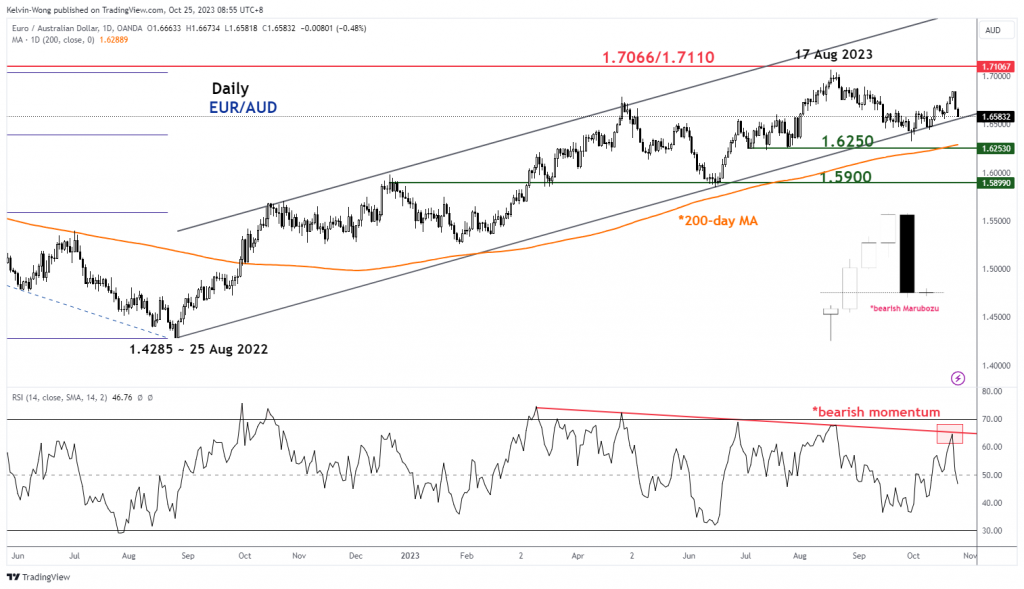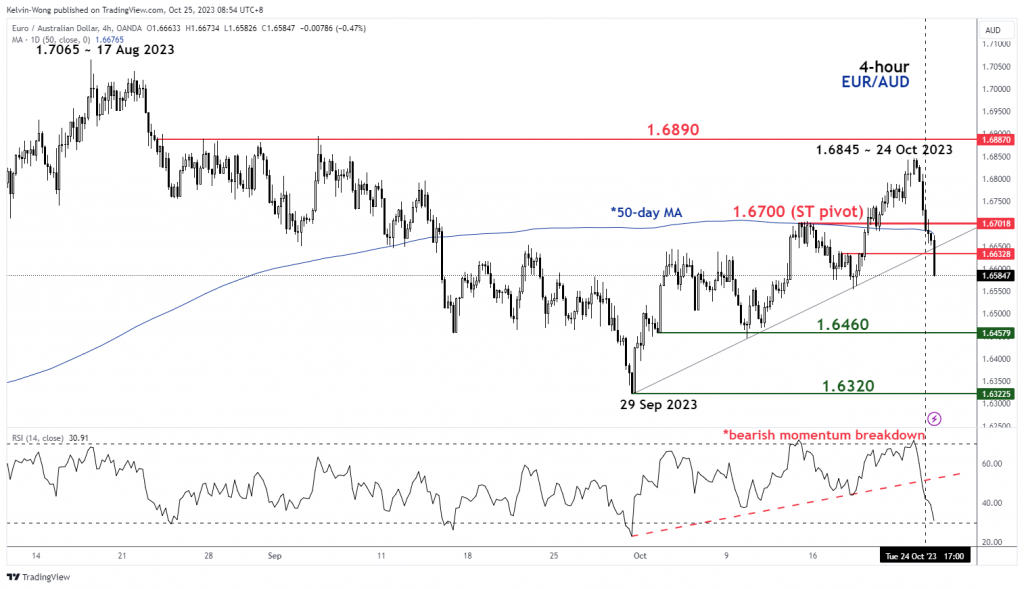- Weak PMI readings from the Eurozone, an increase in China’s budget deficit ratio, and renewed inflationary pressures in Australia may trigger a persistent bearish sentiment loop in EUR/AUD.
- Watch the key short-term resistance at 1.6700 for EUR/AUD.
- A break below 1.6250 key medium-term support on the EUR/AUD may trigger a multi-week bearish impulsive down move.
The Euro (EUR) tumbled overnight throughout the US session as it erased its prior gains against the US dollar recorded on Monday, 23 October; the EUR/USD shed -104 pips from yesterday’s intraday high of 1.0695 to close the US session at 1.0591, its weakest performance in the past seven sessions.
Yesterday’s resurgence of the USD dollar strength has been attributed to a robust set of October flash manufacturing and services PMI data from the US in contrast with weak readings seen in the UK and Eurozone that represented stagflation risks.
Interestingly, the Aussie dollar (AUD) has outperformed the US dollar where the AUD/USD managed to squeeze out a minor daily gain of 21 pips by the close of yesterday’s US session. The resilient movement of the AUD/USD has been impacted by positive news flow out from China, Australia’s key trading partner.
China’s national legislature has just approved a budgetary plan to raise the fiscal deficit ratio for 2023 to around 3.8% of its GDP which was above the initial 3% set in March and set to issue additional sovereign debt worth 1 trillion yuan in Q4. This latest round of additional fiscal stimulus suggests that China’s top policymakers are expanding their initial targeted measures to address the ongoing severe liquidity crunch in the domestic property market as well as to reverse the persistent weak sentiment inherent in the stock market.
In addition, the latest set of Australia’s inflation data surpassed expectations has also reinforced another layer of positive feedback loop in the Aussie dollar which in turn may put Australia’s central bank, RBA on a “hawkish guard” against cutting its policy cash rate too soon.
The less lagging monthly CPI Indicator has risen to an annualized rate of 5.6% in September, above consensus estimates of 5.4%, and surpassed August’s reading of 5.2% which has translated into a second consecutive month of uptick in inflationary growth.
In the lens of technical analysis, a potential bearish configuration setup has emerged in the EUR/AUD cross pair from a short to medium-term perspective.
Major uptrend phase of EUR/AUD is weakening
Fig 1: EUR/AUD medium-term trend as of 25 Oct 2023 (Source: TradingView, click to enlarge chart)
Even though the price actions of the EUR/AUD have been oscillating within a major ascending channel since its 25 August 2023 low of 1.4285 and traded above the key 200-day moving average so far, the momentum of this up movement is showing signs of bullish exhaustion.
Yesterday (24 October) price action ended with a daily bearish reversal “Marubozu” candlestick coupled with the daily RSI momentum indicator that retreated right at a significant parallel resistance in place since March 2023 at the 65 level which suggests a revival of medium-term bearish momentum.
EUR/AUD bears are now attacking the minor ascending support
Fig 2: EUR/AUD minor short-term trend as of 25 Oct 2023 (Source: TradingView, click to enlarge chart)
The EUR/AUD has now staged a bearish price action follow-through via the breakdown of its minor ascending support from its 29 September 2023 low after a momentum bearish breakdown that was flashed earlier yesterday (24 October) during the European session as seen from the 4-hour RSI momentum indicator.
Watch the 1.6700 key short-term pivotal resistance (also the 50-day moving average) for a further potential slide toward the intermediate supports of 1.6460 and 1.6320 in the first step.
On the other hand, a clearance above 1.6700 invalidates the bearish tone to see the next intermediate resistance coming in at 1.6890.
Content is for general information purposes only. It is not investment advice or a solution to buy or sell securities. Opinions are the authors; not necessarily that of OANDA Business Information & Services, Inc. or any of its affiliates, subsidiaries, officers or directors. If you would like to reproduce or redistribute any of the content found on MarketPulse, an award winning forex, commodities and global indices analysis and news site service produced by OANDA Business Information & Services, Inc., please access the RSS feed or contact us at info@marketpulse.com. Visit https://www.marketpulse.com/ to find out more about the beat of the global markets. © 2023 OANDA Business Information & Services Inc.


 .
.
